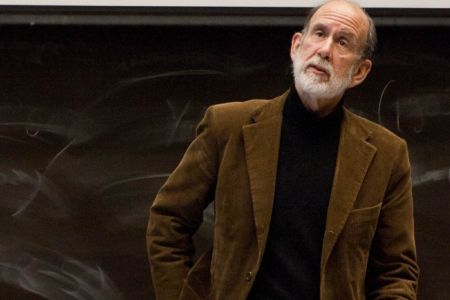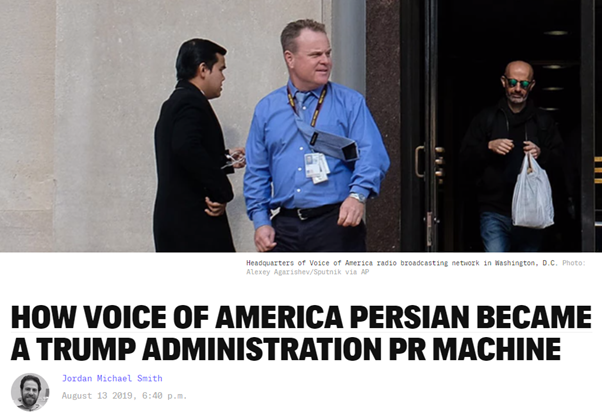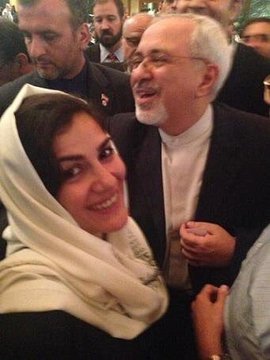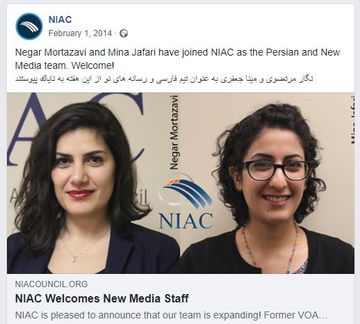On December 21, 2001, intelligence operatives from 3 countries attended a clandestine meeting in an indistinct office building in Piazza di Spagna.
Ghorbanifar has made several appearances in previous threads in this series.
Ghorbanifar is the Iranian arms dealer who was allegedly involved in both the “October Surprise” and the Iran-Contra affair in the 1980’s.
He had managed to keep a low profile during the 1990’s, but in 2001 he was back in the middle of high-stakes political intrigue.
Ghorbanifar brought to the meeting with him several Iranians, including “a very high-level ex-Revolutionary Guard.”
Larry Franklin, a policy analyst and Iran desk officer in the Department of Defense (DoD).
Both Rhodes and Franklin speak Farsi.
At the time, Ledeen was a scholar at the American Enterprise Institute (AEI), a think tank founded by Bill Kristol.
He held no official position in the US government.
A note on sourcing: most of what follows can be found in the Senate Selection Committee on Intelligence 110-345 report published on June 5, 2008.
intelligence.senate.gov/publications/r…
Ledeen initially sought approval for the meeting from a mid-level Defense Dept official.
The meeting was declined.
The meeting was approved by the DoD.
The CIA and the State Dept were only minimally briefed on the meeting; many details were left out, most importantly that Ledeen and Ghorbanifer would be in attendance.
The CIA had previously issued a “burn notice” on Ghorbanifar because the agency considered him a serial fabricator, con man, and possible Iranian intelligence asset.
motherjones.com/politics/2006/…

However, even the DOD claimed to be in the dark about the extent of Italian intel involvement and their motivation for organizing and sponsoring the meeting.
Rhode sent a cable back to the Pentagon that the group had “made contact with Iranian intelligence officers who anticipate possible regime change in Iran and want to establish contact with the United States.”
For a price.
Ghorbanifar needed $5 million as “seed money.”
On December 12, Ledeen met with the United States ambassador to Italy, Marvin Sembler.
The ambassador said the DoD participants “were talking about 25 million [US dollars] for some kind of Iran program.”
Sembler had several concerns:
-- he was not notified in advance of the meeting
-- the DoD participants failed to get “country clearance”
-- Ledeen was not an employee of the US government.
In early February, both the CIA and State Dept opposed any further meetings with the Iranians.
In April 2002, the DoD authorized an “executive referral” for Ledeen to meet with the Defense HUMINT Service.
On July 4, 2002, Ledeen informed Ambassador Sembler that he would be returning to Rome to “resume the program.” Sembler sent a cable back to the US expressing his concern about the legality of the meeting.
Feith was in charge of the notorious Office of Special Plans (OSP).
theguardian.com/world/2003/jul…
According to Ledeen, the reason there was no weapons of mass destruction in Iraq was because they had been moved to Iran.
mcclatchydc.com/news/special-r…

Back then, however, “the Vulcans” were in control of the DoD.
foreignaffairs.com/reviews/capsul…
Meanwhile, Larry Franklin, who shared Ledeen’s passion for regime change in Iran, was growing impatient with the Bush administration.
newyorker.com/magazine/2005/…
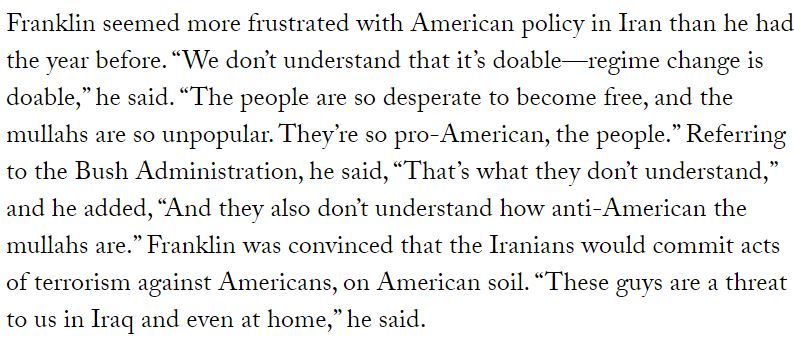
In February 2003, Franklin met with two representatives from the American Israeli Public Affairs Committee (AIPAC) in hopes the organization would lobby the administration on Iran policy.
In June 2004, FBI agents raided Franklin’s home in West Virginia and found 83 classified documents.
The FBI flipped Franklin and set up a sting in which Franklin passed supposedly classified information to AIPAC employee Rosen.
Rosen in turn notified Naor Gilon, Israeli embassy employee and an expert on the Iranian nuclear program. Additionally, Rosen allegedly contacted a Washington Post reporter and leaked the information given to him by Franklin (“I’m not supposed to know this”).
On August 24, 2004, FBI agents sought an interview with Steven Rosen.
Soon after the FBI approached Rosen, Ledeen contacted Franklin. Ledeen arranged for ‘Super Lawyer’ Plato Cacheris to represent Franklin, pro-bono.
nytimes.com/2019/09/26/us/…
As the Franklin espionage scandal was unfolding in the summer of 2004, the New York Times published a series of stories about Ahmad Chalabi, the founder of the Iraq National Congress.
nytimes.com/2004/05/24/wor…
Chalabi, though an Arab, was always considered a suspect ally of the United States because he was a Shiite Muslim and thus potentially sympathetic to the Iranian government.
However, thanks to the efforts of former CIA director James Woolsey, Chalabi became a source for intelligence on Iraq anyway.
In August 2004, Feith was interviewed to determine whether he authorized Franklin’s leaks to AIPAC.
On Sept 6, 2004, Newsweek published an article about a possible “mole” passing classified information to Israel. Ledeen defends Franklin.
web.archive.org/web/2005040603…

On May 3, 2005 Franklin was charged with espionage in a sealed complaint.
fas.org/irp/ops/ci/fra…
Before he entered his plea, Franklin was approached by two men who suggested he fake his suicide and avoid testifying.
forward.com/news/108778/on…
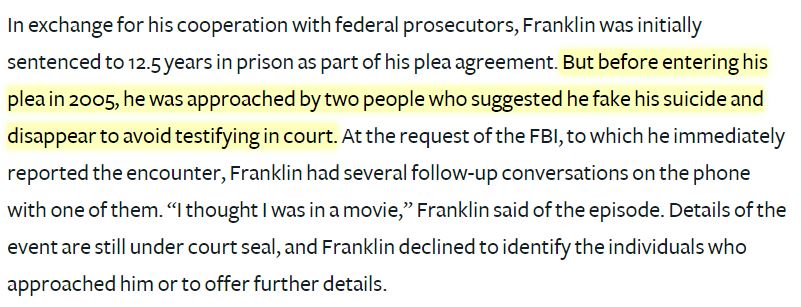
On Jan 20, 2006, Franklin was sentenced to 12 years and 7 months in prison.
nytimes.com/2006/01/20/pol…
The DOJ eventually dropped the charges against the AIPAC employees. After those charges were dropped, the judge reduced Franklin’s sentence to 10 months.
Nevertheless, Franklin’s professional career was ruined. He worked a series of odd jobs in the years after his release.
forward.com/news/108778/on…
Rosen was fired by AIPAC, whom he later sued for defamation. He lost the case.
Gilon was not charged with any crime. He went on to a successful career in the Israeli diplomatic service.
He was Israel’s ambassador to Italy from 2012 to August 2016.
It took me quite a bit of time to create this thread because it required a lot of sourcing to be believable.
In my research, I came across some credible sources that call the previous narrative into question. As it turns out, all may not be what it seems. There may be more to the story.
To be continued...





